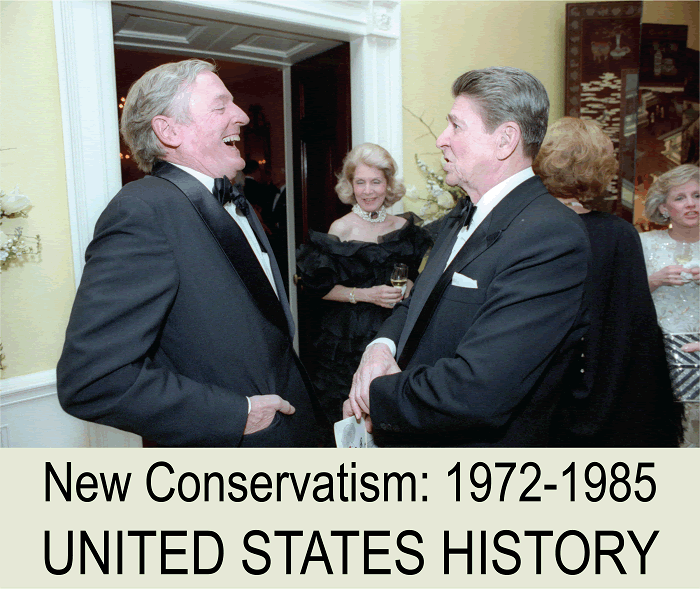Unit 14: New Conservatism, 1972-1985 |
| www.studenthandouts.com > U.S. History > New Conservatism |
| New Conservatism Books & Films | New Conservatism Miscellany |
| New Conservatism Image Galleries | New Conservatism Outlines & Powerpoints |
| New Conservatism Study Games | New Conservatism Worksheets |
The new political conservatism movement in the United States from 1972 to 1985, often referred to as the "New Right" or the "Conservative Revolution," was a significant political and ideological shift that had a profound impact on American politics and policy. Here's an overview of this movement.
 Origins and Background: The conservative movement of this era had its roots in the post-1960s backlash against the perceived excesses of the counterculture, anti-war protests, and social changes. It was fueled by opposition to big government, high taxes, social liberalism, and what conservatives saw as a decline in traditional values and moral standards.
Origins and Background: The conservative movement of this era had its roots in the post-1960s backlash against the perceived excesses of the counterculture, anti-war protests, and social changes. It was fueled by opposition to big government, high taxes, social liberalism, and what conservatives saw as a decline in traditional values and moral standards. Emergence of Key Figures: Several influential conservative figures emerged during this period, including Ronald Reagan, who served as the governor of California and later became President, and Barry Goldwater, who ran as the Republican presidential candidate in 1964. Intellectuals like William F. Buckley, Jr., the founder of the National Review, and Phyllis Schlafly, an activist against the Equal Rights Amendment, played essential roles in articulating and promoting conservative ideas. Conservative Ideology: The New Right embraced a conservative ideology that emphasized limited government, free-market capitalism, lower taxes, and a strong national defense. Socially, they championed what they termed "traditional values," including opposition to abortion, LGBTQ+ rights, school bussing, and feminism. They were often critical of the welfare state and government intervention in the economy. Political Activism: The conservative movement engaged in grassroots political activism, organizing at the local and state levels to influence the Republican Party and promote conservative candidates. Issues like school prayer, opposition to the Equal Rights Amendment, and anti-communism served as rallying points for conservatives. Electoral Success: Ronald Reagan's election as President in 1980 marked a significant victory for the conservative movement. His presidency implemented many conservative policies, including tax cuts, deregulation, and a strong military buildup. The 1984 election saw Reagan's landslide re-election, reinforcing the influence of conservatism. Media Influence: Conservative media outlets and personalities, such as Rush Limbaugh and Fox News, gained prominence in the years following this era, providing a platform for conservative viewpoints. The rise of conservative talk radio and cable news contributed to the dissemination of conservative ideas. Foreign Policy: The New Right also had a strong influence on foreign policy, advocating for a more assertive stance against the Soviet Union during the Cold War. Social Issues: Conservatives strongly opposed the expansion of abortion rights, ultimately resulting in the 2022 Supreme Court decision in Dobbs. They also resisted the Equal Rights Amendment (ERA), which aimed to eliminate gender-based discrimination but was not ultimately ratified. Legacy: The conservative movement of this era reshaped the Republican Party, making it more ideologically conservative. It set the stage for a lasting conservative influence on American politics, contributing to the election of conservative presidents and influencing policy debates for decades to come. Overall, the new political conservatism movement of the United States from 1972 to 1985 was a powerful and influential force that shifted the country's political landscape to the right, leaving a lasting impact on American politics and policy. |
| UNIT I: | Early America | UNIT IX: | Discontent and Reform | ||
| UNIT II: | Colonial Period | UNIT X: | War, Prosperity, and Depression | ||
| UNIT III: | American Revolution | UNIT XI: | New Deal and World War II | ||
| UNIT IV: | New National Government | UNIT XII: | Postwar America | ||
| UNIT V: | Westward Expansion | UNIT XIII: | Decades of Change | ||
| UNIT VI: | Sectional Conflict | UNIT XIV: | New Conservatism | ||
| UNIT VII: | Civil War and Reconstruction | UNIT XV: | Into the Twenty-first Century | ||
| UNIT VIII: | Growth and Transformation | UNIT XVI: | Polarization and Deglobalization |







